Every site owner needs to position their company or brand as high on search engine rankings as possible.
This is why SEO, link building, and a site’s link profile are so important.
But so much of how search engines work is a black box. How can you know if all those hard-acquired backlinks are performing well?
Don’t worry, there are ways.
In this article we look at:
- What link profiles are and why they matter
- What makes a strong link profile
- How to avoid tanking your site’s search engine ranking through a bad link profile
Let’s get into it.
Link building cheat sheet
What is a Link Profile?
Your site’s link profile is made up of the backlinks that point to it and the overall quality of those links.
With every backlink pointing to your landing page or piece of content, your site can perform better in search results.
But, it’s important to remember that it’s not the sheer quantity of inbound links that matters; it’s their quality that ultimately determines how Google and other search engines will rank your page.
A link profile consists of:
- The types of links that are pointing to your pages
- The anchor text of those inbound links
- The way you’ve acquired them
These are the metrics that Google uses in an attempt to discipline website owners into keeping their SEO white-hat and fair.
When it comes to types of links, they should be from legitimate places with high domain authority. The anchors should be diverse and natural, and various link schemes should be avoided.
Link profiles have an impact on every part of a site’s performance, including ranking and building domain authority.
Now that we know what link profiles are and what they consist of, we’ll get into why they are so important.
Why is a Good Link Profile Important?
As we mentioned before, your link profile affects so much of your website’s performance.
SEO experts generally believe that link profiles make up most of a site’s ranking in the eyes of Google’s algorithm.
And if that’s not reason enough to pay attention, it turns out that the penalties Google gives to websites are mostly connected to the quality of the link profile.
From this, it’s clear to see that the strength of the link profile is an important signal to search engines in general. It reveals both the quality of your content as well as whether or not you’re engaging in practices that they deem unfair.
Every once in a while Google either makes changes to its algorithm or reveals a new piece of information – such as that social media platforms signals don’t factor into search rankings.
But, the importance of backlink profiles has not changed in all this time. Proper SEO simply doesn’t work without paying attention to your link profile.
This is why many companies and entrepreneurs regularly put their sites through backlink audits. This type of analysis can tell you if you have a good link profile or a bunch of spammy links.
So, what exactly is a good link profile?
One that means your site is getting quality links from other sites. Relevant links, from sites with high domain authority, and with proper anchor texts. There are many audit tools such as Link Explorer by Moz, Ahrefs and Semrush – and Google Analytics and Google Search Console don’t provide insights on incoming links.
In the next section, we’ll cover in detail exactly what having a good link profile entails.
What Should a Good Link Profile Consist of?
A good link profile is an important part of your SEO that will help you rank higher on Google search results.
It’s not the only thing site owners need to worry about, but all your content marketing strategy and excellent keyword research will be for naught if your backlinks are bad.
Every good link profile has a lot of high-value backlinks from high domain authority sites and next to no spammy low-authority links.
Additionally, you can think about it all like this:
- The most important thing about your site’s ranking is the link profile
- The most important factor in the link profile is the backlink quality
- For backlinks, the most important thing is to consider is the anchor text
- And most significant for anchor texts is diversity
But to drill down further and go in-depth, we’ll take a look at the six most important elements of a good backlink profile to help you see how your website stacks up.
Element #1: High-quality links
Links need to be high-quality, period. A bunch of band links might give you some boost for a short period of time, but very soon you will take a big loss in the form of a penalty.
Two things are key for a search engine to recognize a link as being good: Authority and relevance.
We’ll touch on relevance in the next section, so for now, let’s look at authority.
To understand this, we first need to know that Google, Bing, Yahoo, and others essentially see links as votes of support from one website to another.
So, the more authority someone linking to you has, the more their vote counts.
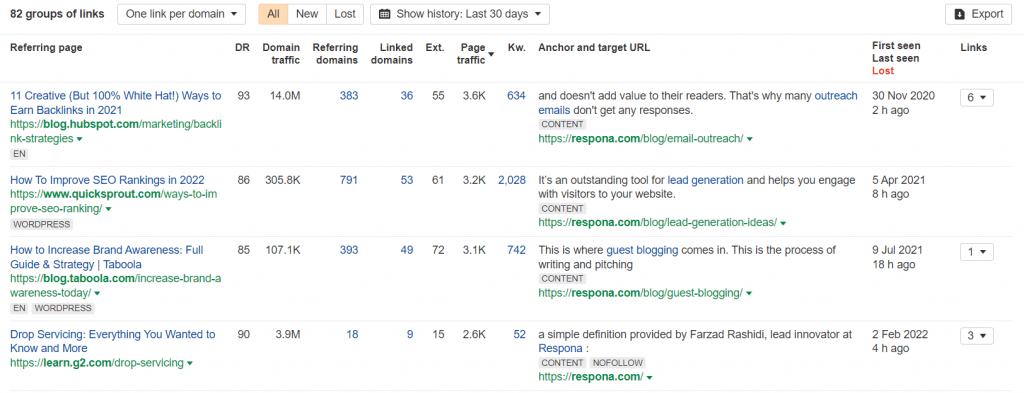
Google uses backlinks to determine your site’s reputation, authority, and expertise in a given subject matter. This is why backlinks from low authority sites simply don’t cut it.
Simply put, high-quality links will boost what the SEO community calls EAT. That stands for Expertise, Authority, Trust.
And the best way to get high EAT is to get backlinks from those sites that have high EATs themselves.
Those who chase a large number of lesser quality links will not see as much improvement in their SERP as those who pursue getting high-quality links from authoritative domains.
Low-quality links are to be avoided at all costs.
Element #2: Relevant links
Next up is relevance – a very important element of link building.
What does it mean for a link to be relevant?
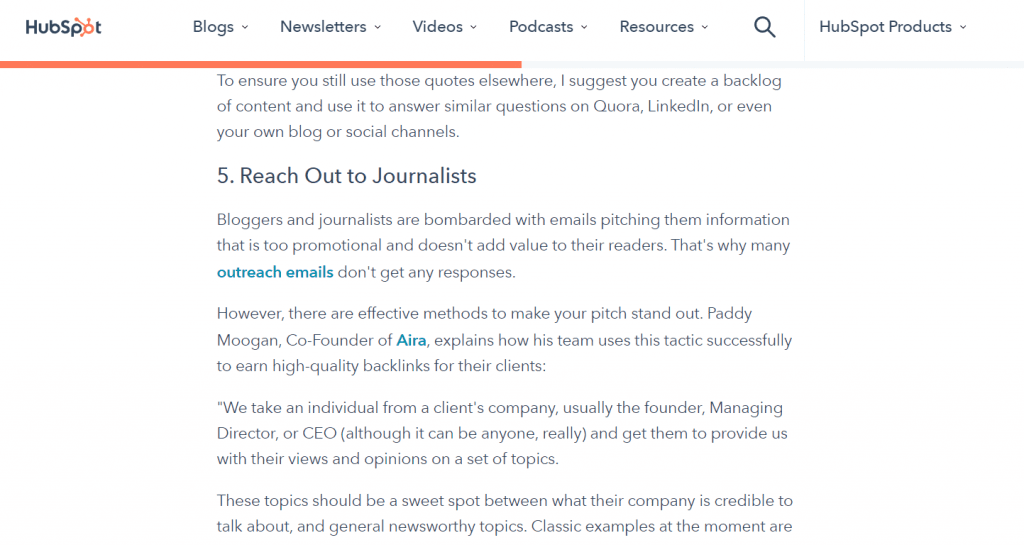
Well, let’s consider a small thought experiment. Let’s say you have a website about content marketing and you just got a backlink from a company in the field of HR recruitment.
Maybe that company’s website is of high domain authority, but since they’re not in your niche, the link will not do as much for your link profile.
It would have been much better if you were linked from related articles on an influential SEO blog.
This is a general principle that’s always in play. The more a website has to do with what you are doing, the more relevant the links are.
It makes intuitive sense too. If you were traveling to a new city, who would you ask for the sights? A friend in that city, or a friend that just lives in the same country?
Element #3: Relevant anchor texts
An anchor is the text part of a hyperlink. And in general, it should always make sense in the context of what’s being linked. If the anchor says “LinkedIn”, the page should have something to do with it.
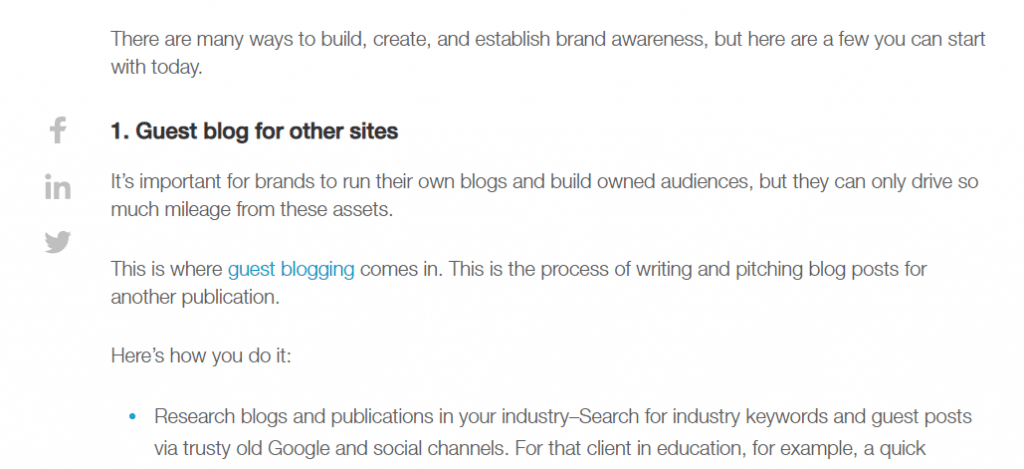
For a very long time, it was thought that the best anchors were ones that exactly matched keywords.
So if your page was about “the best laptops in 2022”, that’s what the backlink anchor should say, too.
However, this has changed after Google rolled out changes to its algorithm in 2013.
Now, search engines prefer more natural anchors. This is what is called a diluted anchor. So instead of an exact match, your link should be placed in a more or less normal sentence.
Some exact-match and keyword strong anchors are still okay, but diversity is now key. Relevant anchors can be diluted, branded, or even just use naked URLs.
There’s a bit of an exception of branded anchors (usually the name of your company or product) which can still be exact matches and point to your URL.
But even here, it’s good to combine them with diluted anchors or with keyword anchors.
Element #4: Surrounding context relevance
Context relevance is another important factor that makes a site’s link relevant and helpful in building a quality link profile.
To understand this, let’s summarize what we know so far: the link needs to come from a high domain authority site, it needs to be relevant, and the anchor itself needs to be relevant too.
Surrounding context relevance has to do with what content surrounds the link and its anchor.
For instance, a link with branded anchor text could come from the SEO blog to your content marketing company. And this is good, but the context matters too.
Is the blog post about keyword research or is it specifically about content marketing? The latter is better than the former for your link profile.
And it’s even better if the page from which you’re getting the backlink has a paragraph that talks about your company.
This is the most relevant surrounding context and it will give the biggest boost to your backlink profile.
Element #5: Link freshness
While it’s important to get backlinks from sites with high domain authority, freshness is also a thing to consider.
Many things in this world go stale, and unfortunately for SEO strategists and site owners, so do backlinks.
Over time, the contribution of a backlink to your link profile falls.
A seven-year-old link from a high DA site probably contributes less than a much fresher link. Even if the site in question has a lower domain authority.
Link freshness is also connected to page freshness. Google scores the pages it indexes by this metric looking at things such as the date of page creation, how often the page is updated, and more.
In brief, you want to have fresh links from sites that are regularly updated with new content.
Element #6: Amount of links
Inbound links are arguably the most important part of off-page SEO and the more of those you have the better. Right?
Well, not always.
A strong link profile is one with many backlinks, but they should not all come from just one source.
Essentially, the more a single site links to you, the less impact it has on your overall link profile.
Remember that a search engine wants to see natural links. The idea is that your content is being linked because it offers value to others.
So, it makes sense that a single source would not link to your landing page over and over again.
The right amount of links for a healthy backlink profile is lots of links but from a diverse set of relevant sites.
In the next section, we will go over what not to do if you want to have a good link profile.
What to Avoid for a Good Link Profile
We’ve done the do’s, so now let’s talk about what not to do if you want a healthy link profile.
These are the three elements that you absolutely must avoid. They don’t do much for your SERP or any of the performance metrics. And even worse, some of these might land you in hot water with Google and give you a penalty.
Here’s how to prevent that from happening.
Element #1: Paid links
This one is simple. Avoid them.
We talked so much about natural backlinks in this article, so it should be obvious that paid links are the opposite of that.
Not to mention that they are also against Google’s terms of service. You should never be paying for links or exchanging any goods and services for them.
According to content guidelines, all sponsored links should be marked as such with the appropriate tag.
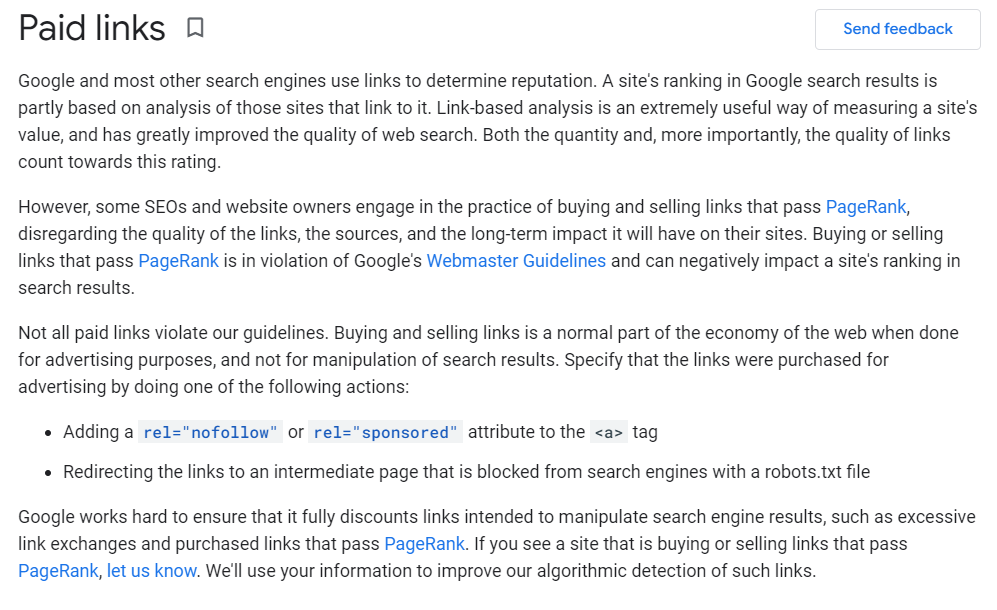
This “sponsored” tag is relatively new and it’s essentially the same as a no-follow link. It won’t pass link authority to you in most cases.
Now, of course, some site owners do pay for links. If you choose to do this, you need to be clever about it. Your paid links should be virtually the same as the ones you haven’t paid for.
This means they should be natural and provide value to users.
If they are obviously paid for and the only goal is to boost search engine rankings, the penalty hammer will come swinging hard and fast.
Element #2: Low-authority links
High-authority links are good. Natural links with good anchors that are made by relevant websites in your niche writing about related topics to your band or product.
Low-authority links – no surprise here – are bad.
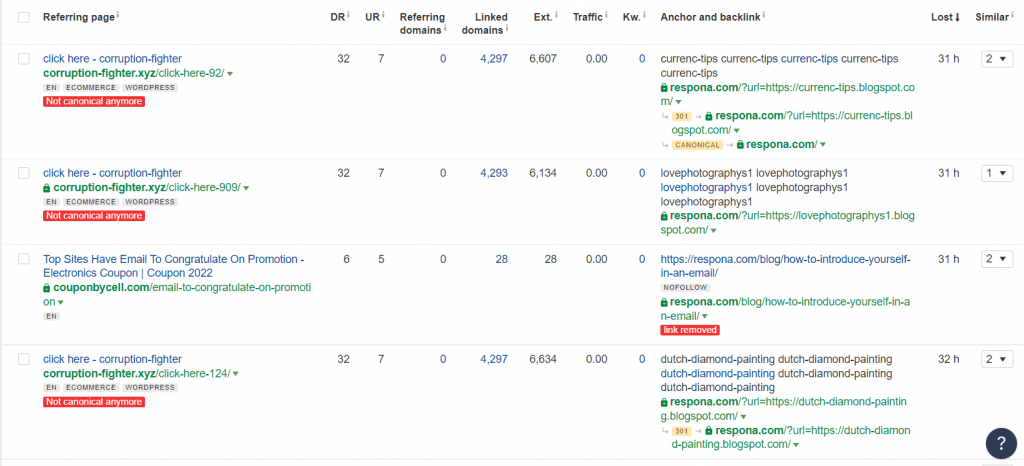
Where are these links found? Most usually in spammy sites and in directories. SEO experts have known for a long time that directory links are dangerous waters.
Getting these types of bad links, from irrelevant sites or directory lists, may even get you a little boost. But over time, it’s another good way to earn a penalty.
When it comes to directories, it’s recommended that you remove such links yourself.
If your link profile analysis discovers a lot of low-authority links from spammy or irrelevant sites, the best thing to do is disavow them.
In the long run, it’s the quality of your inbound links that matters much more than their quantity.
Element #3: No link diversity
The deeper any links go into the structure of your site, the better.
It’s a fact that most of your outbound links will point to your homepage or landing page.
But an oversaturation of such links hurts your link profile.
This is why those links that go to a specific page or post are so important. This can be your About Us section or the articles you post on your blog.
Having your content backlinked this way increases the overall authority of your site. This is because it signals to search engines that you’re producing content worthy of linking and of value to users.
This is where content marketing comes into play as an important factor in your link profile.
The best way to get good links going deep in your site structure is to have high-quality content that others will want to link to.
In conclusion, a good link profile will show high link diversity. Links should go to your homepage, your subpages, and the pieces of content you have published.
In the next section, we’ll give you a brief conclusion of everything important to having a strong link profile.
Link building cheat sheet
Now Over To You
Analyzing your link profile is the best way to see how your link building is performing.
It will also help you boost your off-page SEO and signal to search engines that your site is relevant and provides value to visitors. In turn, this increases your pagerank – or link equity.
In brief, a strong link profile has good backlinks from sites with high authority in the niche you’re in. These links should have good anchor text and should be placed in the proper surrounding context.
Paid links and links from low-authority sites should be avoided. Any bad links you should promptly disavow.
To learn more about how to bring your backlink profile to the next level, start your 14-day free trial with Respona.



![2455 Guest Posting Sites for 2024 [Updated List]](https://respona.com/wp-content/uploads/guest-posting-sites-1024x683.jpg)


